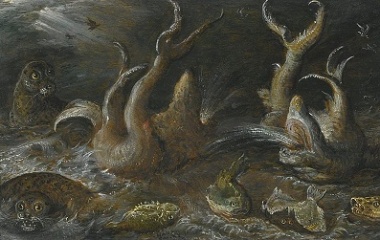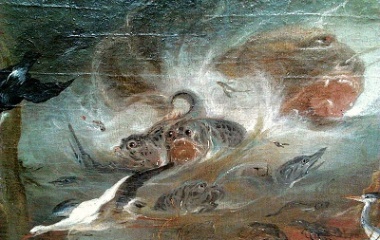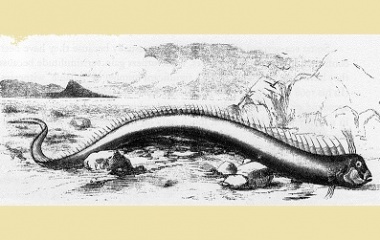What is a Sea Monster?
Spend a few minutes gazing at the ocean’s dark, choppy surface, and you will probably feel the hairs raise on your arms. What could be lurking just below the water? Your imagination’s wildest creations seem possible.
Over the centuries, hundreds of sailors have added their own nightmares to humanity’s collection of Sea Monsters. Each one is different, but they all have one thing in common: bloodlust.
Characteristics
Physical Description
Every Sea Monster is hideous in its own special way, but the menagerie can still be sorted into a few broad categories.
Giant Sea Monsters are unimaginably huge. At the very least, they are large enough to crush boats. At the greatest, they are so large that you cannot see from their head to their tail. It might take days for a ship to sail past one of these monsters!
Serpentine Sea Monsters have long, flexible bodies. They are famous for swimming in an undulating pattern, creating a series of humps that rise and fall above the surface of the water. Their bodies are usually scaly, and they might have spines running along their curved spine. Although they are snakelike, some serpents have legs or flippers.
Tentacled Sea Monsters resemble octopi or squids. Their bodies are rarely seen, since they use their super-sized tentacles to do their dirty work for them. Suction cups help them latch onto their prey and drag it into the depth of the ocean, presumably to a waiting mouth.
Common add-ons for Sea Monsters include blow holes that spout high-pressured water, chimeric features (usually part human or part horse), multiple heads, giant crab-like claws, and of course, razor sharp teeth.
Special Abilities
Just as no two Sea Monsters look the same, no two of them have the same abilities. Each has his own trademark attack!
Some of the more common abilities are creating water spouts, creating whirlpools, having poisonous breath, singing seductively, and summoning sympathetic gods to aid.
Famous Sea Monsters
Only the most fearsome beasts have managed to stand out among the legions of Sea Monsters and claim a place in history. Together, they have claimed hundreds of lives and even re-shaped the maps that explorers use to navigate the ocean.
The Kraken
The Kraken is an ancient beast that lurks in the deep ocean, off the coast of Greenland and Norway. Originally, he was described as a crab-like creature with immeasurable claws, but later, witnesses began to describe him with enormous tentacles.
The Kraken has a peculiar hunting method. He regurgitates food to lure them within reach of his enormous mouth. Then, he shoots out of hiding and nets the regurgitated food, along with swarms of new fish, into his mouth and swallows them. In this way, he can feed without leaving the dark crannies where he hides. He need never travel to the surface of the ocean; only his profound aggression against humans can draw him out of hiding. When a ship sails through his territory, he rockets to the surface, causing so much disturbance in the water that he causes dangerous waves, even whirlpools above him. He might also make a large, booming noise. When he reaches his prey, he ensnares the ship in his mighty tentacles and drags it down to a watery grave.
The Leviathan
The Leviathan is a giant beast, originally from the Mediterranean Sea. He is believed to be a serpent, but he is so large that no one can reliably judge his true nature. Only his head, colorful, horned, and equipped for breathing fire, has been described in detail. Some sources claim that a man can go mad from trying to comprehend the Leviathan’s size.
The Leviathan is a popular spiritual symbol. He made his debut in a Canaanite creation story, which claimed that the serpent was a force of chaos, banished to the depths of the ocean after he lost a duel with the Creator. Later, the Leviathan was picked up by Judaism and Christianity, who interpreted him as both the epitome of evil and greed and as just another one of God’s creations.
Scylla
Scylla was a chimeric beast who plagued ancient Greek sailors. Once a beautiful nymph, her beauty led to her downfall when a jealous witch poisoned the tide pool where she liked to bathe. As soon as Scylla touched the poisoned water, she was transformed into a monster with a tail like a serpent and seven dog heads sprouting from her torso. Horrified, Scylla hid herself in a cave by the ocean.
As years passed, her self-loathing festered into a terrible rage. She began attacking all the ships that sailed by her cave, snatching up a sailor in each of her foul dog heads. Her partner in crime was a terrible whirlpool, called Charybdis, which drove ships to sail close to the cliffs, within Scylla’s reach.
Cthulu
Cthulu is a tentacled monster who roams the depths of the Pacific Ocean. His body is shaped roughly like a man’s, but his head is a mass of tentacles, and dragon wings sprout from his back.
According to a cosmology developed by HP Lovecraft, Cthulu is one of four god-like creatures, nicknamed the “Great Old Ones.” Cthulu represents water, while the other Great Old Ones represent the other elements. As a sort of deity, Cthulu is believed to have extraordinary powers, but he doesn’t use them because he is in a state of hibernation. Even so, his existence emanates dread and anxiety, which eventually worms its way into all living creatures.
Cultural Representation
Origin
Sea Monsters have probably been around for as long as we have been around to imagine them. They are carved and painted in our oldest works of art, and the appear in our first attempts at literature, including Beowulf, The Odyssey, and 1,001 Nights.
Still, the golden age of Sea Monsters didn’t begin until men started embarking on long-distance sea voyages and, even more importantly, trying to map out the perils of the ocean for the travelers who came after them. Medieval maps are adorned with colorful monsters, meant to warn travelers just how life-threatening the journey they are about to embark on is.
Modern Appearances
But Sea Monsters didn’t go away after man had mapped the outlines of all the continents and even tracked the ocean currents and identified its danger zones. Far from it! During the nineteenth century, the deep ocean became a final frontier—and a final hiding place for our imagination’s greatest monsters. Novels like Moby Dick20,000 Leagues Under the Sea added to the lore around sea creatures.
Today, we seem to have lost hope that we will discover a monster to dwarf our dreams, even in the ocean’s deepest, darkest chasms. We’ve stopped inventing new monsters, but that hasn’t spoiled our love of the old ones! The Kraken is especially popular, appearing in films like Pirates of the Carribean and Clash of the Titans.
Explanation
Though we have yet to find a serpent that could be mistaken for an island or an octopus that can generate whirlpools, the idea of Sea Monsters is not entirely unfounded. Millions of years ago, the ocean housed some horrors that could eat today’s apex predators alive.
The Megalodon, for example, was a colossal shark that might have grown up to twenty meters long (five times the size of a great white)! And this was no docile giant. It had jaws full of overlapping teeth, and it preyed on whales. Dakosauruses, pliosaurs, and tylosauruses were serpentine predators who ranged from five to fifteen meters long and were spread all across the globe. If ancient people came across the fossilized remains of these creatures, they could have easily been terrified by the idea that the creatures still stalked the oceans!
Sailors might also have mistaken regular sea creatures for monsters. From a distance, a school of porpoises can look like a series of snake humps gliding through a water. A whale spouting water from its blowhole might have been equally terrifying. Giant squids, which can grow up to five meters long, might have been mistaken for a baby Kraken when they washed ashore.
Sea Monster






No comments:
Post a Comment